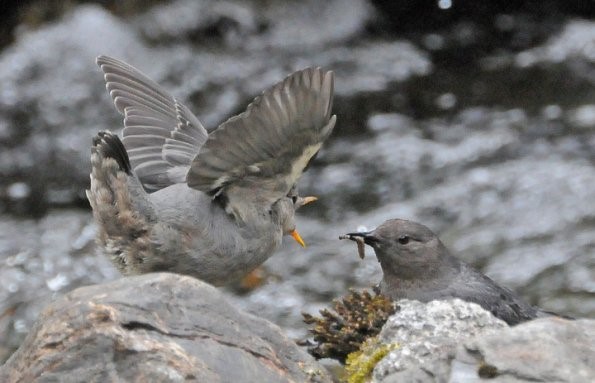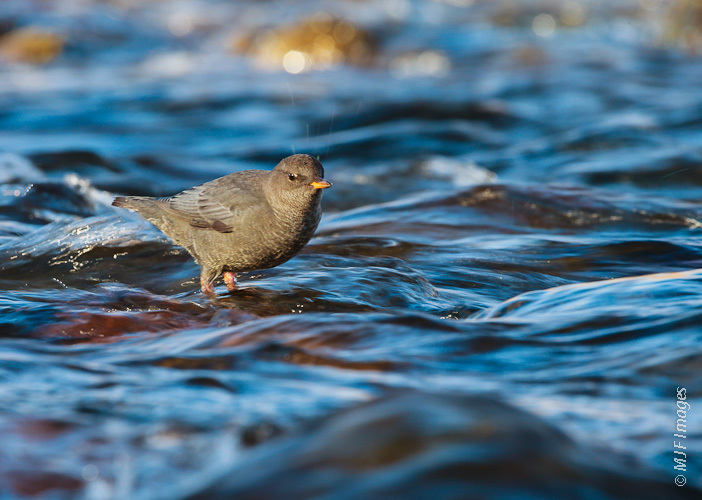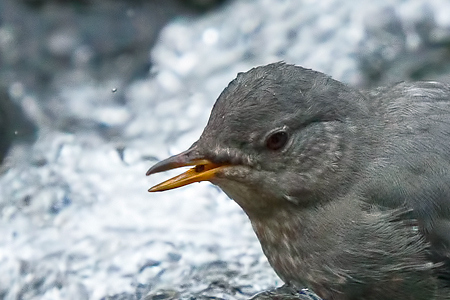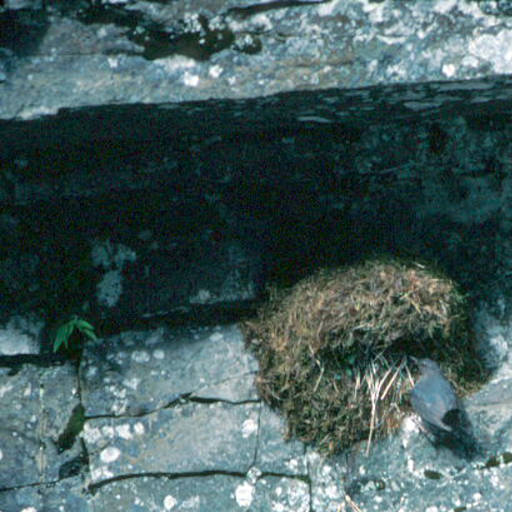
Interactions
The American Dipper is an extremely independent organism and is
typically found by itself, much like the
Ruby-throated Hunningbird. Each bird has its o wn section of stream
where they do their foraging.
One of the only times they will willingly relocate is if they are
forced to move by the environment for reasons like freezing over or
drying out. Some other reasons they may move is migration during the
winter, or if there is a food supply shortage. Otherwise they stay
pretty far away from each other, except when it comes to breeding
time (Gilliard 1958). When it comes time to reproduce the Dippers
start to pair up with a mate. Both sexes are fairly alike to one
another. Both parents help to build the nest, feed the offspring,
and watch over the nest. It is found that the mother does slightly
more work than the father (Austin 1961).
wn section of stream
where they do their foraging.
One of the only times they will willingly relocate is if they are
forced to move by the environment for reasons like freezing over or
drying out. Some other reasons they may move is migration during the
winter, or if there is a food supply shortage. Otherwise they stay
pretty far away from each other, except when it comes to breeding
time (Gilliard 1958). When it comes time to reproduce the Dippers
start to pair up with a mate. Both sexes are fairly alike to one
another. Both parents help to build the nest, feed the offspring,
and watch over the nest. It is found that the mother does slightly
more work than the father (Austin 1961).
American Dipper’s are extremely territorial birds and do not appreciate other organisms intruding. Although they are typically joyous and loveable birds, when they are disturbed they can be aggressive, especially during the winter when food sources are limited, (Whitehorne 2010). To maintain their territory they must try to scare off other birds. To do this they do a neck stretching display to make themselves look intimidating, and also chase the unwelcomed organism (Perrins et al. 1985). Surprisingly enough when we look at the food web for the spring streams in which the dippers live we find that they are actually the top predator (Parker et al. 2006). They are great predators in this area because they are very high energy birds.
 As I
previously explained, American Dippers usually feed from flowing
rivers and streams. They consume a wide variety of organisms. They
seek insect larvae that cling to the rocks and will go all the way to
the bottom of streams in search of various aquatic insects that live
among the rocks and debris (Reilly 1968). Some of the aquatic
insects they consume are water beetles and caddis flies. They also
enjoy eating snails, mollusks, tadpoles, fish eggs and small fish,
just like the
Red-winged Blackbird.
It is surprising how versatile they are and how many different
things they can eat.
As I
previously explained, American Dippers usually feed from flowing
rivers and streams. They consume a wide variety of organisms. They
seek insect larvae that cling to the rocks and will go all the way to
the bottom of streams in search of various aquatic insects that live
among the rocks and debris (Reilly 1968). Some of the aquatic
insects they consume are water beetles and caddis flies. They also
enjoy eating snails, mollusks, tadpoles, fish eggs and small fish,
just like the
Red-winged Blackbird.
It is surprising how versatile they are and how many different
things they can eat.
Some things that may threaten the population of American dippers are
logging, mining, and construction. Construction is not always
a bad thing for the Dippers because they sometimes make their nests
under bridges, so
 when the
creation of roads bring about a new bridge it can supply the birds
with new places to make their nests. The American Dipper is beneficial to humans in the way that it makes
a fairly good bio indicator. This means that it is a good detector
of how well the environment is doing. They’re sensitive to stream
degradation and pollution which indicates the water quality (Parker
et al. 2006). Therefore to know if the water quality is good we can
look at the health of the American Dipper. One way the American
Dippers health can be measured is by looking at the body mass of the
birds. When the ecosystem is not doing well, the American Dippers
food source will lessen, making them weigh less and possibly have to
relocate to find food (Feck et al. 2004). By monitoring the size of
population and mass of birds we can determine whether the ecosystem
is doing well or not. By being able to catch problems early on we
can prevent human illness and costly cleanups.
when the
creation of roads bring about a new bridge it can supply the birds
with new places to make their nests. The American Dipper is beneficial to humans in the way that it makes
a fairly good bio indicator. This means that it is a good detector
of how well the environment is doing. They’re sensitive to stream
degradation and pollution which indicates the water quality (Parker
et al. 2006). Therefore to know if the water quality is good we can
look at the health of the American Dipper. One way the American
Dippers health can be measured is by looking at the body mass of the
birds. When the ecosystem is not doing well, the American Dippers
food source will lessen, making them weigh less and possibly have to
relocate to find food (Feck et al. 2004). By monitoring the size of
population and mass of birds we can determine whether the ecosystem
is doing well or not. By being able to catch problems early on we
can prevent human illness and costly cleanups.